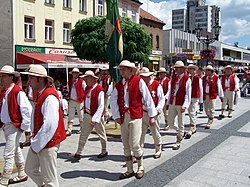
Back الاقليه البولنديه فى جمهورية التشيك ARZ Поляци в Чехия Bulgarian Poláci v Česku Czech Pola minoritato en Ĉeĥio Esperanto Polacy w Czechach Polish
A request that this article title be changed to Poles in the Czech Republic is under discussion. Please do not move this article until the discussion is closed. |
 | |
| Total population | |
|---|---|
| 38,218 (2021 census)[1][a] | |
| Regions with significant populations | |
| Trans-Olza:[2] 37,117 (2001 census) | |
| Languages | |
| Polish, Czech, Cieszyn Silesian | |
| Religion | |
| Roman Catholicism (57.02%), Lutheranism (15.84%) and Atheism (11.51%) (1991 census)[3][b][c] | |
| Related ethnic groups | |
| Czechs and Slovaks |
The Polish minority in the Czech Republic is a Polish national minority living mainly in the Trans-Olza region of western Cieszyn Silesia. The Polish community is the only national (or ethnic) minority in the Czech Republic that is linked to a specific geographical area.[4] Trans-Olza is located in the north-eastern part of the country. It comprises Karviná District and the eastern part of Frýdek-Místek District. Many Poles living in other regions of the Czech Republic have roots in Trans-Olza as well.
Poles formed the largest ethnic group in Cieszyn Silesia in the 19th century, but at the beginning of the 20th century the Czech population grew. The Czechs and Poles collaborated on resisting Germanization movements, but this collaboration ceased after World War I. In 1920 the region of Trans-Olza was incorporated into Czechoslovakia after the Polish–Czechoslovak War. Since then the Polish population demographically decreased. In 1938 it was annexed by Poland in the context of the Munich Agreement and in 1939 by Nazi Germany. The region was then given back to Czechoslovakia after World War II. Polish organizations were re-created, but were banned by the Communist Party of Czechoslovakia. After the Velvet Revolution Polish organizations were re-created again and Trans-Olza had adopted bilingual signs.
- ^ "Národnost" (in Czech). Czech Statistical Office. Retrieved 2 March 2022.
- ^ Czech Statistical Office
- ^ Szymeczek, Józef (April 2007). "Obywatele narodowości polskiej na ziemiach czeskich wg wyznania 1930–1991 (table)". Zwrot: 20.
- ^ Cite error: The named reference
ECwas invoked but never defined (see the help page).
Cite error: There are <ref group=lower-alpha> tags or {{efn}} templates on this page, but the references will not show without a {{reflist|group=lower-alpha}} template or {{notelist}} template (see the help page).